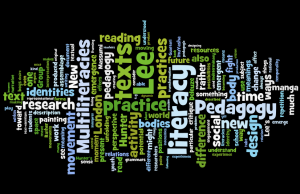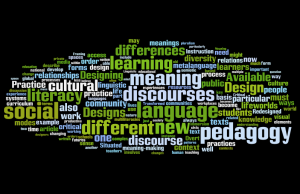The New London Group is a collective of 10 researchers who met in 1994 to discuss what they perceived to be a fundamental societal problem:
that the disparities in educational outcomes did not seem to be improving. We agreed that we should get back to the broad question of the social outcomes of language learning, and that we should, on this basis, rethink the fundamental premises of literacy pedagogy in order to influence practices that will give students the skills and knowledge they need to achieve their aspirations. (NLG, 1996)
In their “programmatic manifesto,” they outline a number of changes that demand corresponding changes in instructional methodologies. These include the following:
-
– Changes in Technology for Knowledge Mobilization
– Changes in Workplace (e.g., PostFordism and Fast Capitalism)
– Changes in Public Lives (e.g., privatization, deregulation, corporatization of education — market logic)
– Changes in Political Logic (e.g., Old World [standardization] / New World [assimilation] logic)
– Shifts in cultural and linguistic diversity
In contemplating how to move forward, they introduce the notion of design, which “recognizes the iterative nature of meaning-making, drawing on Available Designs to create patterns of meaning that are more or less predictable in their contexts” (NLG, 1996). Designing, they argue, “always involves the transformation of Available Designs; it always involves making new use of old materials” (NLG, 1996). They also note that Available Designs are varied, identifying the following: Linguistic Design, Visual Design, Audio Design, Gestural Design, Spatial Design, and Multimodal Design. For students to be successful, they argue, they invariably require a metalanguage to describe and reflect on their design process.
Finally, the New London Group observes
pedagogy is a complex integration of four factors: Situated Practice based on the world of learners’ Designed and Designing experiences; Overt Instruction through which students shape for themselves an explicit metalanguage of Design; Critical Framing, which relates meanings to their social contexts and purposes; and Transformed Practice in which students transfer and re-create Designs of meaning from one context to another. (NLG, 1996; bold added)
The above-summarized document is one of the most cited in contemporary literacy research. Although the authors describe it as “open and tentative,” and welcome debate and elaboration, there has been little critique of the ideas espoused. Rather, as Leander and Boldt (2013) observe, “More than any other document, ‘A Pedagogy of Multiliteracies’ streams powerfully through doctoral programs, edited volumes, books, journal reviews, and calls for conference papers, as the central manifesto of the new literacies movement,” and is the dominant conceptual paradigm in new literacy studies. A design paradigm, they posit, is not the only way to conceptualize literacy studies and has some key limitations.
Contemplating the NLG article and the above discussion, here are some questions for your consideration:
- 1. What appears to be the premise, or purpose, of education in the NLG’s view? Are there other valid purposes of education that might productively be considered?
2. In 1994 the NLG were concerned that “the disparities in educational outcomes did not seem to be improving.” In your estimation has there been any advancement in terms of erosion of such disparities? If not, why not?
3. To what extent are students availing themselves of the gamut of “Available Designs”? If they are not doing so, what might be the main barriers?
4. Look up the definition and etymology of design in multiple sources, including the OED. Do you feel the paradigm introduced — learning as design — is a useful one? Are you able to propose any other productive approaches?
5. The NLG notes that they are from disparate parts of the world; however, the ten researchers represent only 3 countries: Australia, Britain and the United States. Expanding on question 3, what approaches might have emerged in a meeting of a more diverse group of researchers?
6. A key challenge identified in education is that young people appear to shift from an innate desire to learn in preschool and non-formal settings to recalcitrance in formal settings. Some claim, in keeping with the NLG manifesto, that this is because content and instructional approaches are too far removed from students’ diverse experiences and interests. Would you agree and, if so, is the approach identified by the NLG one way to ameliorate this challenge?
7. Finally, contemplate the two images at the bottom of this post. These images, as you likely know, are “Wordles,” essentially simple visualizations of the word frequency in two different documents, where larger words represent greater instance of that term in the document (“stop words” — common English words — are omitted here so that the focus can be on “content” words). The texts visualized are the NLG article (1994) and Leander and Boldt’s response (2013). Which is which? Can anything be gleaned about the nature or focus of these texts from simply examining word frequency in these two documents?
Upload your group’s thoughts on these questions as a comment to this post.
__________
References
Leander, K., & Boldt, G. (2013). Rereading “A Pedagogy of Multiliteracies” Bodies, Texts, and Emergence. Journal of Literacy Research, 45(1), 22-46. (UBC Electronic Holdings)
New London Group. (1996). A pedagogy of multiliteracies: Designing social futures. Harvard Educational Review, 66(1), 60-92.


4 replies on “The Multiliteracies Manifesto: Twenty Years On”
Ellis, Kathryn, Mary, Annie:
1. We see the purpose of this article as one that encourages students to practice being global citizens, who understand cultural diversities and can apply them to their learning. Furthermore, we think that students need to be global citizens via local community engagement and volutnteerism, and to move away from the idea that global citizenship means having an international focus, since there are international issues in local communities (i.e. downtown East side).
Ellis, Kathryn, Mary, Annie:
6. We need to used all literacies and modalities to reach all students! This may entail bringing in literacies that we as teachers are not necessarily comfortable with (i.e. allowing students the opportunity to dance, sing, perform, create visual art, etc. to tell stories or respond to work).
As teachers and students, we must be critical of all literacies. We must teach our students how to be critically literate of all literacies, whether print or not.
Thoughts from Cat, Chris, Christa, Steph, Fatima, Lisa, Andrew, & Sarra on Question 6
We agree that teachers/schools/curriculum etc. remove the educational relevance that engages students in learning. Through introducing multiliteracies, teachers can appeal to a broader audience and a greater selection of learning styles. However, it does depend on how you approach it; you have to frame everything with background knowledge and promote discussion (ex. don’t just show a youtube video because “it’s fun”).
Ideally, multiliteracies should be used as a supplemental tool, not a lesson plan. Often, teachers end up trying to force in different variations of the lesson that might not be as effective as focusing on 2 or 3.
We need to look at our incorporation of multiliteracies: are we getting away from the text or are we just adding ways to understand the text?
I found the idea that students seem to shift from an innate desire to learn in informal settings to a recalcitrance to learn in formal higher level grades to be particularly interesting. I think that the school system works to mould students to a particular idea of how they should think, read, write, and learn and that this causes students to either lose their abilities to express themselves in other ways or to have their expression suppressed by the “right” way of expressing them selves in the academic classroom.
I found this particularly interesting in looking at the differences between grade 8 and grade 12 and in looking at the differences between elementary and secondary students. In my practicum I found the the older grade levels were much more resistant to alternative activities in lessons. The grade 8 students were much more willing to participate in activities that got them up and moving around the room, while it took a lot of coaxing to get the grade 11 and 12 students to participate. In talking to another student teacher, she said that she did a survey of her grade 12 students and she found that they felt she was doing too much group work – they wanted to sit at their desks and work by themselves. I think that this is partially a product of the high stakes provincial testing that students are facing in the older grades and partially a product of how the students have been conditioned to learn throughout sir schooling career.
The difference between elementary and high school students is even more telling. I had the opportunity to work with the YMCAs after school care for my enhanced practicum so I was working with students from K-5. I found that the younger kids were much more open to new people and new activities and that they were very creative in their after school play. It is interesting but many people lose their ability to play as they get older and I think that this is one sign of losing some of the creativity that is seen in young kids but seems to be lost as many people grow up and continue through the school system.